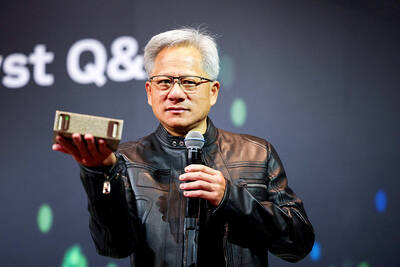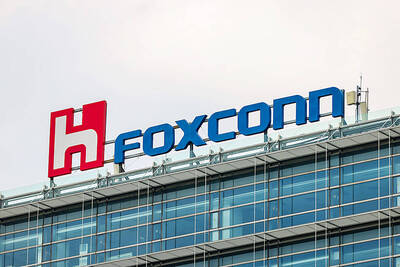It may have slipped from its golden age into its golden years, but two decades into the Internet era the fax machine is still, perhaps surprisingly, holding its place in many offices.
While it has been reduced to a small player in the rapidly growing world of digital communications, “millions of people still use fax machines daily worldwide and probably will continue to do so in the near future,” said Jonathan Coopersmith, an associate professor at Texas A&M University, who has written a book on the history of the once ubiquitous office machine.
Even more surprising, people and companies continue to buy new fax machines.

Photo: AFP
“Sales are dropping regularly due to e-mails, but the market is far from disappearing,” said Nicolas Cintre, deputy director in France for Japanese company Brother Industries Ltd, the market leader in fax machines.
About 20 million fax terminals were sold in 2005, manufacturers estimate, while sales today are on the order of several million.
“The market is holding up. Those who predicted the death of the fax 10 years ago were wrong,” Cintre said.
Part of the reason for the machine’s survival is an attachment among “older generations” who spent most of their careers using it, he said.
“Some habits are hard to break,” he said.
It is considered by some as a tool for older employees reluctant to learn new technologies, but the fact that it embraces handwriting — in particular signatures — has also helped the fax avoid obsolescence.
“Fax machines allow sending signed documents, which are considered as originals, which isn’t the case with e-mail,” said Jean Champagne, head of Sagemcom Canada, the unit of the communications equipment company that markets fax systems.
Coopersmith said that “in most countries, faxing is concentrated in certain areas such as banking, real estate, legal communications and medicine — where a written signature is necessary.”
Regulations might require faxing in some countries, he added.
Champagne also said that faxes offer advantages in terms of confidentiality and security, another reason why the machines remain popular in the legal and medical fields.
“It is nearly impossible to intercept fax transmissions. Documents cannot be manipulated,” he said.
The fax has aged better in some countries than others. In the US, fax machines have pretty much disappeared. Xerox Corp, which built the first machine for the general public, stopped selling basic models several years ago.
However, in Japan, where they have long been an essential feature of homes as well as offices, faxes are still in widespread use. They were even deployed by the authorities in 2011 to disseminate some information during the Fukushima Dai-ichi nuclear accident.
“Per capita, the greatest fax use still occurs in Japan, especially among older people who grew up writing by hand, not typing on a keypad,” Coopersmith said.
It is not just the elderly — many Japanese users of varying ages favor the fax for allowing them to send off handwritten notes.
“For many people and small businesses, faxing a written note or a form is easier than typing on a computer or smartphone,” Coopersmith added.
Nearly 1.2 million basic fax machines were sold in Japan last year, and sales are forecast to dip to 1.1 million this year, according to the association of telecommunications companies.
“The use of fax machines fell with the massive spread of computers and smartphones, but people over 60 who are not familiar with the new technologies prefer the fax,” said Miyuki Nakayama, spokesman for electronics manufacturer Sharp Corp.
Europe is somewhere in the middle, according to Cintre.
In France, about 40,000 basic fax machines were sold in 2013, according to market researcher GfK.
Though sales of simple fax machines are declining, that does not necessarily mean that faxes are disappearing. Instead, the fax is increasingly being wrapped into “multi-function” or “all-in-one” machines that are gaining popularity in the market. These offer consumers printing, scanning, photocopying and faxing functions.
This is the direction that Brother, Cannon Inc, Epson Corp and Hewlett-Packard Co have taken. Others are using software to mimic fax functions, essentially sending facsimiles as attachments to e-mails.
“This sector is booming,” said Champagne, who said the “faxware” sector is growing by nearly 20 percent per year.
So even if fax machines eventually disappear, the fax function will endure in other devices in homes and offices
“Faxing will decline as its older users die but it will not disappear,” Coopersmith said. “If nothing else, faxing serves as an inexpensive and backup emergency communications system.”

SEEKING CLARITY: Washington should not adopt measures that create uncertainties for ‘existing semiconductor investments,’ TSMC said referring to its US$165 billion in the US Taiwan Semiconductor Manufacturing Co (TSMC, 台積電) told the US that any future tariffs on Taiwanese semiconductors could reduce demand for chips and derail its pledge to increase its investment in Arizona. “New import restrictions could jeopardize current US leadership in the competitive technology industry and create uncertainties for many committed semiconductor capital projects in the US, including TSMC Arizona’s significant investment plan in Phoenix,” the chipmaker wrote in a letter to the US Department of Commerce. TSMC issued the warning in response to a solicitation for comments by the department on a possible tariff on semiconductor imports by US President Donald Trump’s

‘FAILED EXPORT CONTROLS’: Jensen Huang said that Washington should maximize the speed of AI diffusion, because not doing so would give competitors an advantage Nvidia Corp cofounder and chief executive officer Jensen Huang (黃仁勳) yesterday criticized the US government’s restrictions on exports of artificial intelligence (AI) chips to China, saying that the policy was a failure and would only spur China to accelerate AI development. The export controls gave China the spirit, motivation and government support to accelerate AI development, Huang told reporters at the Computex trade show in Taipei. The competition in China is already intense, given its strong software capabilities, extensive technology ecosystems and work efficiency, he said. “All in all, the export controls were a failure. The facts would suggest it,” he said. “The US

The government has launched a three-pronged strategy to attract local and international talent, aiming to position Taiwan as a new global hub following Nvidia Corp’s announcement that it has chosen Taipei as the site of its Taiwan headquarters. Nvidia cofounder and CEO Jensen Huang (黃仁勳) on Monday last week announced during his keynote speech at the Computex trade show in Taipei that the Nvidia Constellation, the company’s planned Taiwan headquarters, would be located in the Beitou-Shilin Technology Park (北投士林科技園區) in Taipei. Huang’s decision to establish a base in Taiwan is “primarily due to Taiwan’s talent pool and its strength in the semiconductor

French President Emmanuel Macron has expressed gratitude to Hon Hai Precision Industry Co (鴻海精密) for its plan to invest approximately 250 million euros (US$278 million) in a joint venture in France focused on the semiconductor and space industries. On his official X account on Tuesday, Macron thanked Hon Hai, also known globally as Foxconn Technology Group (富士康科技集團), for its investment projects announced at Choose France, a flagship economic summit held on Monday to attract foreign investment. In the post, Macron included a GIF displaying the national flag of the Republic of China (Taiwan), as he did for other foreign investors, including China-based